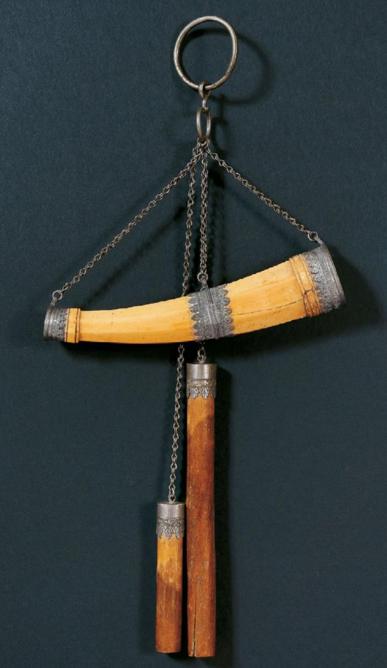Is St Francis’ Horn Egyptian? April 20, 2016
Author: Beach Combing | in : Medieval , trackback
A medieval ivory horn is pictured with two mysterious wooden rods, which look like nunchaku, but were actually ‘silence sticks’, banged together before a sermon. The horn is kept at Assisi among the most precious relics of St Francis (obit 1226), because this horn, says tradition, was brought back by Francis from Egypt as a gift from Sultan al-Kamil, when Francis, recklessly went to preach Christianity to the Muslim ruler in 1219 and somehow escaped with his life. Subsequently Francis used, so tradition claims, the horn to call the friars of his order to prayer. This object, then, claims to be the living memory of a remarkable meeting between the leader of the Muslim east and the most interesting Christian of the high Middle Ages, only is it really?
The problem with the horn itself is that it is a fairly anonymous object. It would be extremely difficult to date. However, the records of the friars minor, do give us some assistance here. First, the object appears in a Franciscan catalogue in 1348, so it has certainly long been associated with St Francis. Second, and even more important the horn was reinforced by three pieces of silver and these carry a script of the I-made-this type. They read ‘with this bell St Francis called the people to preaching and banging these sticks together he ordered silence: Giovanni di Nicoluccio made me in Assisi’. Giovanni di Nicoluccio appears in Siennese records of the time and there is no question that he existed. His work floruit is tentatively dated to the 1230s or the 1240s. In other words these silver pieces were placed within perhaps twenty years of Francis’ death.
There is no question that the horn is a precious relic of St Francis’ time, then. But can it really be traced back to the meeting with al-Kamil? The first life of Francis, by Thomas of Celano, claimed that al-Kamil offered treasures to the Italian holyman but that Francis ‘scorned them like dung’. Thomas’ life is, in any case, rather vague on this episode – he claims the conversation took place in ‘Syria’! It is possible that the Sultan offered great treasures and Francis picked the one not-so-valuable thing from the pile: a lowly and unadorned ivory horn. That would certainly be characteristically Francis.
However, there is another explanation that occurs to this historian’s jaded mind. In the late fourteenth century (1390), Bartolomeo Pisano noted that St Francis would call the people together with the horn, following a curious custom he had encountered in Egypt. (Francis in his own writings talks of the rightness of calling the people together with a ‘crier’.) That curious custom is presumably the Muslim call to prayers. Now Bartolomeo is a later writer and his claim is rather peculiar: perhaps it could be argued that it is so peculiar that it has to be true… But it does not claim that the ivory horn came from Egypt only that it was used to enact an adapted Muslim custom. It is easy to see how from there later readers and the later Franciscan custodians of the horn made the connection with the story of gifts from the Sultan. The horn carries in its small interior the echoes of a remarkable meeting, but that it actually sealed that meeting is, unfortunately, unproven.
Sources includes Tartuferi, D’Arelli, L’Arte di Francisco (Firenze 2015)
Invisible writes 30 Apr 2016: Fascinating post about Francis’s horn! It is now possible to identify the area of origin of ivory through DNA–this applies to new ivory, though, and I do not know if it would work with the horn. It would definitely be possible to tell if this is elephant, narwhal, walrus, mammoth ivory, or some other material, which might or might not rule it out a present from the Sultan.


